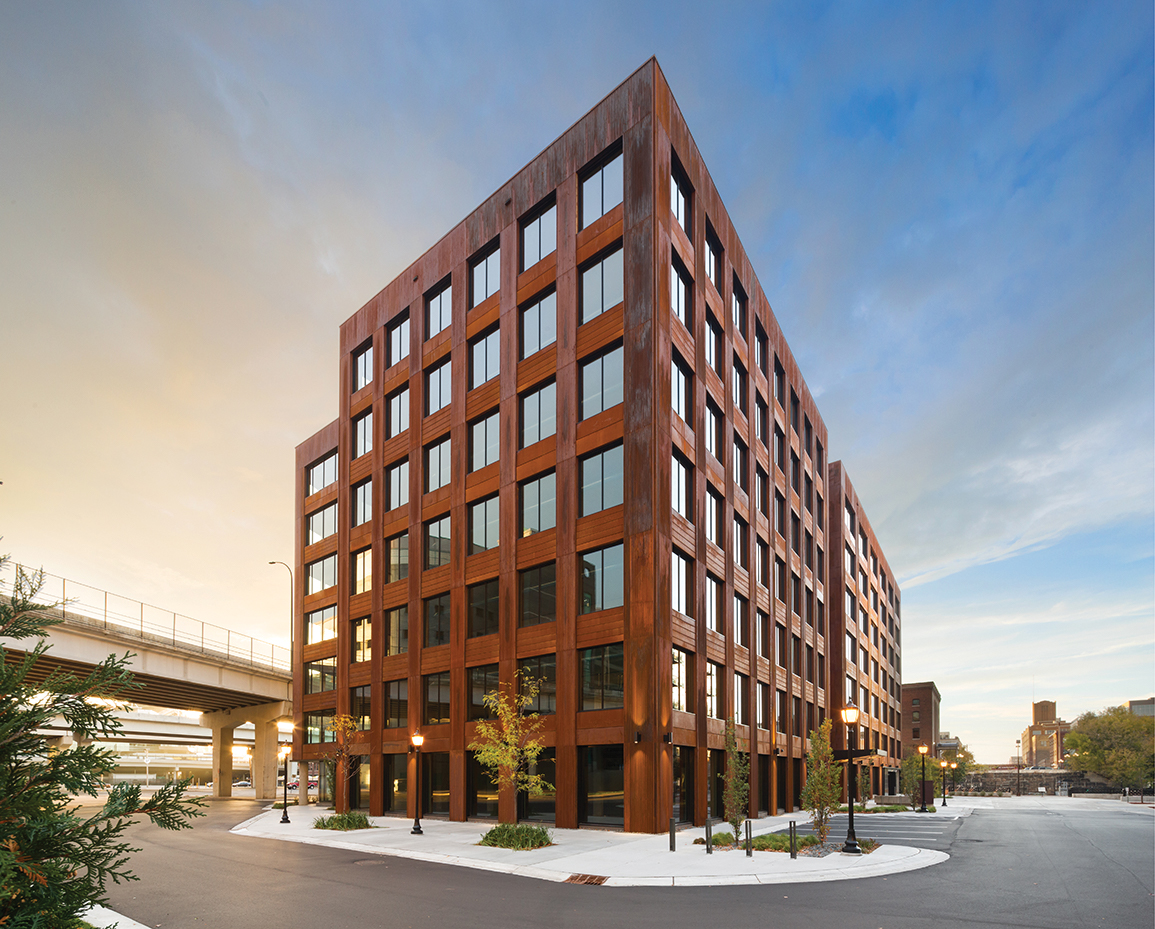Building Materials Matter
Towards a Sustainable Future
Technical innovations and the availability of next-generation lumber and mass timber systems are at the heart of an emerging movement to reduce carbon footprint and other environmental impacts by considering wood for larger, taller structures. Tall buildings are a vital part of urban settings, as they make efficient use of limited space. In this regard, they promote urban density, which is thought to have beneficial sustainability aspects. Most notably, compact cities promote sustainable transportation methods such as walking.
Examples of mass timber buildings include (among others) a 10-story cross-laminated timber (CLT) apartment in Australia, and eight- and nine-story CLT apartments in the United Kingdom. Closer to home is the T3 office building in Minneapolis, a 220,000-square-foot structure, and Brock Commons Tallwood House, an 18-story student residence in British Columbia.
A recent LCA study showed that the environmental impact of the WIDC, compared with a similar baseline concrete building, was 10 percent less than the concrete building in six of seven categories. This LCA also indicated that a multistory office building constructed with mass timber systems and laminated veneer lumber (LVL) curtain walls has an overall lower environmental impact than a similar building constructed of reinforced concrete structural systems with aluminum curtain wall structures.44
Recognizing the need to reduce their own carbon footprints, the steel and concrete industries are working to improve the efficiency of manufacturing and construction processes as well as the environmental and structural properties of their products. According to the World Steel Association, for example, the steel industry over the last 40 years has reduced its energy consumption per ton of steel produced by 50 percent over. However, Edwin Basson, director general of the association, says energy represents one of the key challenges for today’s steel industry and is directly related to its environmental impact.
In terms of concrete, new technologies have led to reductions in direct CO2 emissions (e.g., through the use of alternative fuels) as well as indirect emissions from electricity use. Highlighting this achievement, companies in the global cement database increased cement production by 53 percent between 1990 and 2006, while absolute net emissions increased by only 35 percent.46 According to the Cement Sustainability Initiative, this trend cannot continue with existing technologies. Rather, a "break-through technology" is needed for significant further improvement.

Photo courtesy of MBH Architects, photo Larry A. Falke
The U.S. commercial building stock is relatively old, with about half of all buildings constructed before 1980.45 As these buildings are eventually replaced, designers have an opportunity to reduce environmental impact by using wood for both structure and finishes. Designed by MBH Architects, the 6,500-square-foot Yard House Bar and Grill in Chino Hills, Calif., includes a variety of wood products, including dimension lumber framing, solid Douglas fir truss posts, Douglas fir glulam beams, wood I-joists and plywood sheathing.
Conclusion
With growing pressure to reduce the environmental impacts of buildings, architects and engineers are looking beyond operational performance to the role of structural materials. Reasons to use wood to achieve a project’s sustainability goals are in many ways intuitive.
Wood grows naturally, is renewable and has advantages from a carbon footprint perspective. It is also durable, adaptable and can have positive impacts on a building’s occupants. However, understanding a material’s impacts at every stage of its life is essential—and LCA studies consistently show that wood has a favorable environmental profile compared with functionally equivalent products made from other materials.
It is worth reiterating that no one material is the best choice for every application. There are trade-offs associated with each, and each has benefits that could outweigh the other material choices based on a project’s design objectives.

Approximately 3,600 cubic meters of wood are used in the T3 office building, in Minneapolis, which will sequester about 3,200 tons of carbon for the life of the building. The seven-story, 220,000-square-foot commercial building offers a mix of retail and office space.
Additional Resources
Think Wood
www.ThinkWood.com
Think Wood connects you to in-depth research, tools, CEU courses, case studies, code and technical experts, and more, to inspire ingenuity and demonstrate all the possibilities of wood in the built environment.
Wood Products Council, WoodWorks
www.woodworks.org
If you’re working on a multifamily wood building project, technical assistance related to all of these concepts is available from WoodWorks-Wood Products Council, either by contacting your local representative (www.woodworks.org) or by emailing the help desk at help@woodworks.org.
American Wood Council (AWC)
www.awc.org
The American Wood Council (AWC) is committed to ensuring a durable, safe and sustainably built environment. To achieve these objectives, AWC contributes to the development of sound public policies, codes and regulations that allow for the appropriate and responsible manufacture and use of wood products. The AWC supports the utilization of wood products by developing and disseminating consensus standards, comprehensive technical guidelines, and tools for wood design and construction, as well as providing education regarding their application.
End Notes
1. Architecture 2030, architecture2030.org/buildings_problem_why/
2. Wooden building products in comparative LCA: A literature review—International Journal of Life Cycle Assessment, 12(7): 470-479, F. Werner, K. Richter,2007
3. A Synthesis of Research on Wood Products and Greenhouse Gas Impacts, FPInnovations, 2010
4. www.athenasmi.org/our-software-data/impact-estimator/; woodworks.org/design-tools/online-calculators/
5. A Synthesis of Research on Wood Products and Greenhouse Gas Impacts, Sarthre, R., and J. O’Connor, 2010, FPInnovations
6. Environmental Life Cycle Inventory of Portland Cement Concrete, Portland Cement Association
7. www.eia.gov/todayinenergy/detail.cfm?id=11911
8. www.cement.org/cement-concrete-applications/concrete-materials/cement-types
9. www.cement.org/cement-concrete-applications/how-cement-is-made
10. www.cemexusa.com/ProductsServices/Cementproductionprocess.aspx
11. www.concrete.org.uk/fingertips-nuggets.asp?cmd=display&id=141
12. NAVEDTRA 1425 Chapter 1
13. www.madehow.com/Volume-2/Iron.html
14. www.mine-engineer.com/mining/open_pit.htm
15. science.howstuffworks.com/iron.htm
16. steel.org/steel-technology/how-its-made/steelmaking-flowlines.aspx
17. corporate.arcelormittal.com/who-we-are/from-ore-to-steel
18. web.mit.edu/12.000/www/m2016/finalwebsite/problems/mining.html
20. www.wbcsdcement.org/index.php/key-issues/climate-protection/technology-roadmap
21. Design for Deconstruction, Chartwell School
22. FPInnovations, calculated using the Athena Impact Estimator for Buildings
23. International Council on Mining & Metals, via www.miningfacts.org
24. A Synthesis of Research on Wood Products and Greenhouse Gas Impacts, Sarthre, R., and J. O’Connor, 2010, FPInnovations
25. Utilization of Harvested Wood by the North American Forest Products Industry, 2012, Dovetail Partners Inc.
26. www.cement.org/cement-concrete-applications/how-concrete-is-made
27. www.nrmca.org/concrete/data.asp
28. www.cement.org/cement-concrete-applications/products/ready-mixed-concrete
29. archive.epa.gov/sectors/web/html/steel.html
31. Guide for Designing Energy-Efficient Building Enclosures for Wood-Frame Multi-Unit Residential Buildings in Marine to Cold Climates in North America, 2013, FPInnovations
32. Wood and Human Health, Issue 1, FPInnovations; Wood as a Restorative Material in Healthcare Environments, FPInnovations, 2015
34. Calculated by Dovetail Partners using data from the US Forest Service and Natural Resources Canada
35. American Forests: A History of Resiliency and Recovery, Douglas W. McCleary, 1997, Forest History Society
36. The State of America’s Forests, 2007, Society of American Foresters; State of the World’s Forests, 2007, United Nations Food and Agriculture Organization
37. USDA Forest Service, Forests on the Edge project, www.fs.fed.us/projects/four-threats/#space
38. CEUs related to the fire protection of wood buildings, wind-resistant design and seismic design can be found at www.thinkwood.com/CEUs.
39. Survey on Actual Service Lives for North American Buildings, FPInnovations, Proceedings, 10th International Conference on Durability of Building Materials and Components
40. Ibid.
41. Understanding Steel Recovery and Recycling Rates and Limitations to Recycling, Dovetail Partners Inc., 2015
42. Based on data reported by the U.S. Geological Survey (2014) and Canadian Steel Producers Association (2015)
43. www.sfiprogram.org, www.pefc.org, www.fsc.org, www.forestfoundation.org
44. Wood Innovation and Design Centre Whole Building Life Cycle Assessment, FPInnovations
45. Commercial Buildings Energy Consumption Survey
46. World Business Council for Sustainable Development, Cement Sustainability Initiative
 |
Think Wood is a leading education provider on the advantages of using softwood lumber in commercial, community and multifamily building applications. We identify and introduce innovators in the field to our community of architects, engineers, researchers, designers and developers. If you need additional support or resources, contact us at info@ThinkWood.com. For additional CEUs, visit ThinkWood.com/CEU. |









